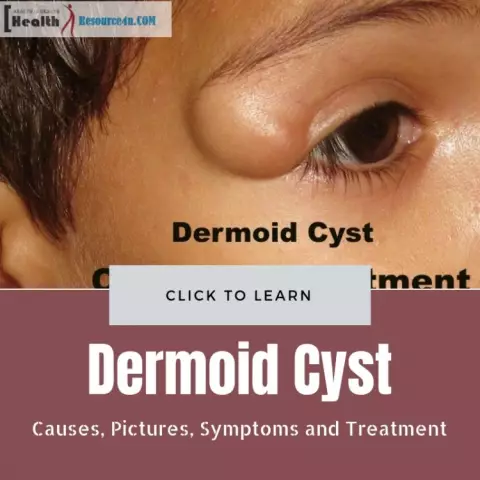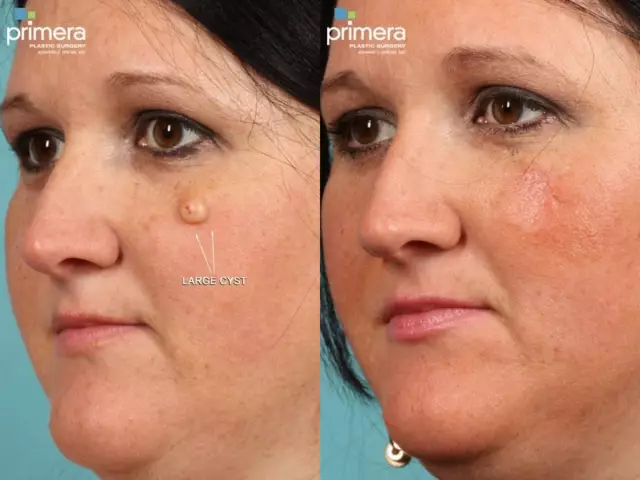- Author Rachel Wainwright [email protected].
- Public 2023-12-15 07:39.
- Last modified 2025-11-02 20:14.
Endometrioid ovarian cyst
The content of the article:
- Causes and risk factors
- Symptoms of an endometrioid ovarian cyst
- Diagnostics
- Treatment of an endometrioid ovarian cyst
- Potential consequences and complications
- Forecast
- Prevention
Endometrioid ovarian cyst is a benign cavity neoplasm of the ovary, the cavity of which is filled with menstrual blood.
The disease is one of the forms of endometriosis - a pathology caused by the ingress of cells of the inner lining of the uterine cavity (endometrium) into the abdominal cavity, vagina, ovaries, fallopian tubes. It often occurs in women between the ages of 20 and 50. Endometrioid cysts can be located on one or both ovaries, their size can reach 12-15 cm in diameter. The histological structure of endometrioid ovarian cysts differs from other types of cystic formations by the absence of glands in their walls.
Often they are accompanied by other gynecological diseases (endometrial hyperplasia, uterine fibroids).

The exact causes of endometrioid ovarian cysts have not been established.
Causes and risk factors
Currently, several theories have been put forward for the occurrence of endometrioid ovarian cysts. Most experts believe that retrograde menstruation leads to their development. Under the influence of certain reasons during menstrual bleeding, a small amount of blood, together with the endometrial cells contained in it, enters the abdominal cavity through the fallopian tubes, where the endometrial cells take root on the surface of an organ and begin to function there.
The drift of small clusters of endometrial cells into the abdominal cavity can also be observed as a result of surgical procedures, during which the uterine mucosa is traumatized:
- diathermocoagulation of the cervix;
- medical abortion;
- diagnostic curettage of the uterine cavity.

In most cases, retrograde menstruation leads to the development of an endometrioid ovarian cyst.
It is also suggested that the cause of the formation of endometrioid ovarian cysts can be a weakening of the immune responses of a woman's body, genetic defects (familial forms of the disease), metaplasia of the remnants of embryonic tissue.
The results of numerous scientific studies have proven the existence of a connection between the occurrence of endometrioid ovarian cysts and some disorders of the endocrine system:
- dysfunction of the adrenal cortex;
- dysfunction of the thyroid gland;
- increased levels of prolactin and / or estrogen;
- decrease in progesterone levels.
The provoking factors for the development of endometrioid ovarian cysts can be:
- living in adverse environmental conditions;
- obesity;
- liver dysfunctions;
- oophoritis (inflammation of the ovaries);
- endometritis;
- prolonged wearing of an intrauterine device (IUD);
- strong emotional stress.
Trapped in the abdominal cavity and engrafted on the surface of the ovaries, areas of the endometrium retain their hormonal dependence and activity. Every month they undergo a menstrual reaction, that is, on the days of menstrual bleeding, they also bleed. Gradually, the endometrioid tissue in the cortical layer of the ovary grows, and endometrioid cysts are formed, filled with dark brown contents. Therefore, they are often called "chocolate cysts" of the ovaries.
Symptoms of an endometrioid ovarian cyst
The severity of the symptoms of the endometrioid ovarian cyst is determined by a number of factors, for example, the psychological state of the patient, the presence or absence of concomitant diseases, the degree of spread of the endometriotic process.
In some patients, a symptom of an endometrioid ovarian cyst is impaired reproductive function (infertility, recurrent miscarriage). In some patients, the disease is generally asymptomatic. But in most cases, endometrioid ovarian cysts are manifested by chronic pain syndrome. The pains are of varying intensity and are localized in the lumbar region or lower abdomen. They intensify with intercourse, during menstruation and intense physical exertion. If the capsule ruptures and the contents of the cyst are poured into the abdominal cavity, then the patient develops peritonitis, which is clinically manifested by the onset and increase of symptoms of an acute abdomen.

The main symptoms of an endometrioid ovarian cyst are chronic pain in the lower back and lower abdomen
Symptoms of an endometrioid ovarian cyst are also:
- menstrual irregularities (lengthening of the menstrual cycle, heavy menstrual bleeding, spotting spotting before and after menstruation);
- increased body temperature;
- general weakness.
As the size of the endometrioid cyst increases, the ovarian tissue undergoes characteristic changes, as a result of which the degeneration of the eggs occurs, scars and follicular cysts are formed. These changes disrupt the normal functioning of the ovaries.
The long existence of the endometrioid ovarian cyst causes the development of an adhesive process in the pelvic cavity, leading over time to dysfunction of the bladder and intestines. Clinically, this process is manifested by the following signs:
- dysuric phenomena;
- flatulence;
- constipation.
Diagnostics
An endometrioid ovarian cyst during a two-handed gynecological examination is defined as a painful sedentary formation in the ovary, the size of which increases before menstruation.
To confirm the diagnosis, the patient undergoes ultrasound examination of the pelvic organs, magnetic resonance imaging, and diagnostic laparoscopy.
Doppler analysis allows you to detect the absence of blood flow in the wall of the endometrioid ovarian cyst.
In the presence of infertility, hysteroscopy and hysterosalpingography are indicated.
With endometrioid ovarian cysts, the serum level of the CA-125 tumor marker may be slightly elevated.
The most accurate method of diagnosing endometrioid cysts today is laparoscopy.

Ultrasound examination is one of the methods for diagnosing endometrioid ovarian cysts
Be sure to perform a histological examination, since endometrioid ovarian cysts can become malignant.
It is rather difficult to diagnose an endometrioid ovarian cyst in case of suppuration of its contents or rupture of the capsule. These conditions are accompanied by the emergence of a symptom complex of an acute abdomen. In this case, the disease is differentiated from a number of other pathologies: complications of ectopic pregnancy, acute urinary tract infection, irritable bowel syndrome, ulcerative colitis, Crohn's disease, adhesions of the pelvic region, acute salpingitis and other conditions.
Treatment of an endometrioid ovarian cyst
The choice of treatment for endometrioid ovarian cysts is determined by many factors (stage of the disease, duration of its course, severity of symptoms, reproductive disorders, patient's age, presence of extragenital and / or genital pathology). Therapy for endometrioid ovarian cysts is aimed at:
- prevention of further growth of cystic formation;
- elimination of clinical symptoms of the disease;
- the fight against infertility.
Currently, the following types of treatment for endometrioid ovarian cysts are used in clinical practice:
- conservative (hormonal therapy, non-steroidal anti-inflammatory drugs, enzyme therapy, vitamins, immunomodulators);
- surgical (removal of the endometrioid ovarian cyst by laparotomic or laparoscopic access);
- combined.
Conservative therapy is usually carried out with small endometrioid ovarian cysts. Patients are prescribed long-term (at least 6 months) hormonal therapy, carried out by the following drugs:
- low-dose monophasic OC (oral contraceptives);
- prolonged forms of MP (medroxyprogesterone acetate);
- derivatives of norsteroids;
- synthetic GnRH agonists (gonadotropin-releasing hormones);
- androgen derivatives.
With the proliferation of endometrioid tissue, the patient complains of intense pain in the lower abdomen, lower back. For their relief, non-steroidal anti-inflammatory drugs, antispasmodics and sedatives are prescribed.
Indications for surgical removal of the endometrioid ovarian cyst are:
- ineffectiveness of ongoing conservative therapy;
- the size of the cystic formation is over 5 cm;
- infertility;
- high risk of complications;
- oncological alertness.
In young women planning to have children in the future, it is undesirable to perform radical operations, consisting in removing the endometrioid cyst together with the ovary (adnexectomy, oophorectomy). In this case, preference is given to partial resection of the ovary or enucleation of the cystic formation.

In young women, if surgical removal of the cyst is necessary, they resort to partial resection of the ovary
To reduce the risk of disease recurrence, preliminary and postoperative hormone therapy is indicated. Hormone therapy in the preoperative period allows to reduce the inflammatory response of ovarian tissue, blood supply and functional activity of endometrioid ovarian cysts, to reduce their size. After the operation, the appointment of hormonal drugs ensures the regression of the remaining cells of the endometrioid focus and thereby reduces the risk of re-development of the "chocolate" ovarian cyst.
In the postoperative period, physiotherapeutic treatment is carried out, the purpose of which is to prevent the re-formation of endometrioid ovarian cysts, infiltrative and adhesions, and correction of endocrine disorders. Patients are usually prescribed radon baths, acupuncture, laser therapy, magnetotherapy, CMT therapy, endonasal galvanization, phonophoresis, ultrasound, electrophoresis.
Potential consequences and complications
Endometrioid ovarian cyst is a serious gynecological disease that, if untreated, can lead to complications:
- suppuration of the contents of the cyst;
- rupture of the cyst wall;
- peritonitis;
- sepsis;
- chronic pelvic pain syndrome;
- infertility.
Forecast
Timely treatment of the endometroid ovarian cyst in most cases leads to the recovery of patients. Their pain stops or significantly decreases, menstrual and reproductive functions are restored. After the end of treatment, the woman should remain under the dispensary supervision of a gynecologist. She undergoes ultrasound examinations of the pelvic organs and the determination of the level of the CA-125 tumor marker in the blood over time. This allows you to timely identify recurrences of the endometrioid cyst, as well as malignant neoplasms of the ovary.
Prevention
Prevention of the formation of endometrioid ovarian cysts includes the following measures:
- timely detection and treatment of inflammatory diseases of the genital organs, hormonal imbalance;
- the use of contraception, which avoids induced abortion;
- avoidance of casual sex;
- strengthening the body's defenses;
- regular preventive examinations by a gynecologist (at least twice a year) and an annual ultrasound examination of the pelvic organs.
YouTube video related to the article:

Elena Minkina Doctor anesthesiologist-resuscitator About the author
Education: graduated from the Tashkent State Medical Institute, specializing in general medicine in 1991. Repeatedly passed refresher courses.
Work experience: anesthesiologist-resuscitator of the city maternity complex, resuscitator of the hemodialysis department.
The information is generalized and provided for informational purposes only. At the first sign of illness, see your doctor. Self-medication is hazardous to health!






